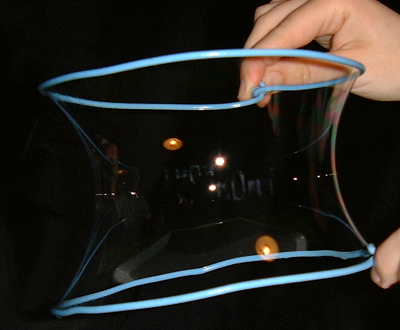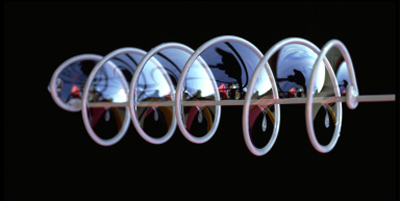
Over the last 250 years mathematical objects called minimal surfaces have been playing hide and seek with geometers, turning themselves into irresistible objects of study in the process. Spencer Becker-Kahn is one mathematician who has joined the quest to find them.
The notion of a minimal surface comes from something we're all familiar with. When blowing soap bubbles you first dip a circular plastic frame into soapy water. The film which then forms within the plastic loop, before you actually blow the bubble, takes the simplest shape possible: it's perfectly flat without any bumps or bulges. This flat shape minimises surface tension (nature likes to be frugal) and it also minimises area. If the soap film had bulges and bumps, then its surface area would be bigger.
“When people first coined the term 'minimal surfaces' they asked some very innocent questions, which turned out to be much deeper mathematical themes than they originally knew."Spencer Becker-Kahn
The disc-shaped soap film (to be precise the mathematical idealisation of the film) is an example of an area minimising surface. The shape of the frame (a circle, a triangle, or something more twisted) dictates the shape of the resulting area minimising surface, so each such surface is defined by the shape of its boundary.
Minimal surfaces
A minimal surface is a slightly more general beast. If you draw a (sufficiently small) loop of any shape on the surface, then the bit of surface inside the loop needs to be the area minimising surface defined by that loop. But the entire minimal surface itself doesn't need to minimise any area.
"One analogy I sometimes use to explain minimal surfaces is to imagine walking in a straight line," explains Becker-Kahn. "In theory, if you do this for a very long time, you go all around the surface of the Earth and you come back to a point which is just a few metres behind you. Clearly you haven't taken the shortest path between your start point and your end point — to do that you should have walked backwards a few steps. But at any given time during your journey you were taking the shortest path between where you were and the point right in front of you."
"So this big circle around the surface of the Earth captures the property that if you take a little small portion of it, what you're looking at is the shortest path between its two end points. But if you stand back and look at the whole object it's obviously not the shortest path to take." Analogously, a minimal surface is made up of lots of area minimising surfaces without itself needing to be one.
The simplest example of a minimal surface is the two-dimensional plane. If you draw a closed loop on the plane and ask for the surface of minimal area that takes the loop as its boundary, you'll find that this surface is exactly the bit of plane that lies inside the loop. Any other shape will have bulges or bumps, which will always lead to a bigger area. As a whole, though, the plane can't be considered an area minimising surface, not least because it doesn't come with a boundary to define the area that needs to be minimised.
Finding minimal surfaces
But what other minimal surfaces are there apart from the plane? That's the interesting question. At the end of the 18th century, even after mathematicians such as Leonhard Euler and Joseph-Louis Lagrange had turned their attention on the subject, only two other minimal surfaces were known. One was the catenoid, an illustration of which can be formed with soap using two pieces of frame, and the other was the helicoid, which looks a bit like an infinite spiral staircase with a ramp instead of steps. The 19th and 20th centuries saw minimal surface theory go in and out of fashion, with 'golden ages' followed by stagnation. Today the quest for finding more, and understanding them properly, is far from complete.

This soap film represents a piece of the catenoid. The actual catenoid has no boundary and continues indefinitely towards the top and bottom.

This soap film represents a piece of the helicoid. The actual helicoid is unbounded and continues indefinitely in all directions. Photo © The Exploratorium.
Yet, despite periods of slow progress, the quest for minimal surfaces opened up fertile mathematical ground. "One thing that isn't often conveyed to people outside of academic mathematics is how easy it is to ask questions that are completely impossible for any human mathematician to solve," says Becker-Kahn. "It's also very common to ask a question which turns out to be completely trivial, so a week later you wonder [why you were even thinking about the question at all]."
"The rarer situation is to have a plentiful supply of questions which are just right. That's when a field starts to gain steam, and that just seemed to happen with minimal surfaces. When people first coined the term they asked some very innocent questions which turned out to be much deeper mathematical themes than they originally knew."
Some of these themes eventually spawned questions in other areas of mathematics where they developed a life of their own. Becker-Kahn's PhD thesis focussed on questions of this nature in the area of analysis, though he wasn't even aware of this at the start. As he gradually found out that minimal surfaces had provided the motivation for his PhD work he became enthralled by the beauty of the subject.
Pinched and wrinkled
Becker-Kahn is particularly interested in minimal surfaces that are a little more awkward than you would like them to be. "Sometimes you can't quite find a minimal surface that is a nice smooth sheet and is pretty and elegant to look at," he explains. You might be able to prove that a given method for constructing a surface produces a surface that's minimal, but not be able to rule out that this surface intersects itself, or is pinched, or badly contorted in some way.
"Ideally you'd like a more beautiful theorem at the end which rules out the possibility of your surface looking crumpled, wrinkled or pinched. But sometimes we don't know how to do that, so we are very interested in studying these regions of minimal surfaces where you get these [so-called singularities]. These 'bad' areas retain some of the properties of area minimisation, but they are not a smooth surface. We can use lots of the ideas and techniques that come from studying the classical setting of minimal surfaces, but often with a lot more analytical machinery to understand what the surface looks like close to the [singularities]."
Studying singularities is one aspect of minimal surface theory, but the field has many more strings to its bow. For example, some researchers look for minimal surfaces in spaces other than the ordinary three-dimensional space we are used to. The idea that infinitely many minimal surfaces should exist in certain such settings has only recently been confirmed by a proof. "And obviously, as soon as you close off one question you realise there's another one coming," says Spencer. "It's very exciting!"
Back to Cambridge
Becker-Kahn took up his position as Unestablished Lecturer at the Department of Pure Mathematics and Mathematical Statistics in October this year, but he is no stranger to Cambridge. He completed his Bachelor and Masters degrees in mathematics at the University of Cambridge, and then did his PhD here under the supervision of Neshan Wickramasekera. His return to Cambridge marks the end of a five year stint in the US where he worked in postdoctoral positions that combined research and teaching.
So how does he enjoy being back? "It's certainly a very nice place to work," he says. "With most mathematicians, if you catch them at the right time and ask them the right question, you'll discover that they feel very passionately about their work. In Cambridge, perhaps more than in most universities in the world, the culture and ethos of department seems to reflect that very well."
"Moreover, teaching the students here is an amazing experience. When you lecture here you really feel like you are talking to a room full of mathematicians. The course I have been teaching this term, I took ten years ago as an undergraduate. I'm lecturing it thinking, 'wow this stuff is really hard, this is harder than I remember it!'."
"It's just amazing what the students can cope with. You can connect with them over some very advanced mathematics."
